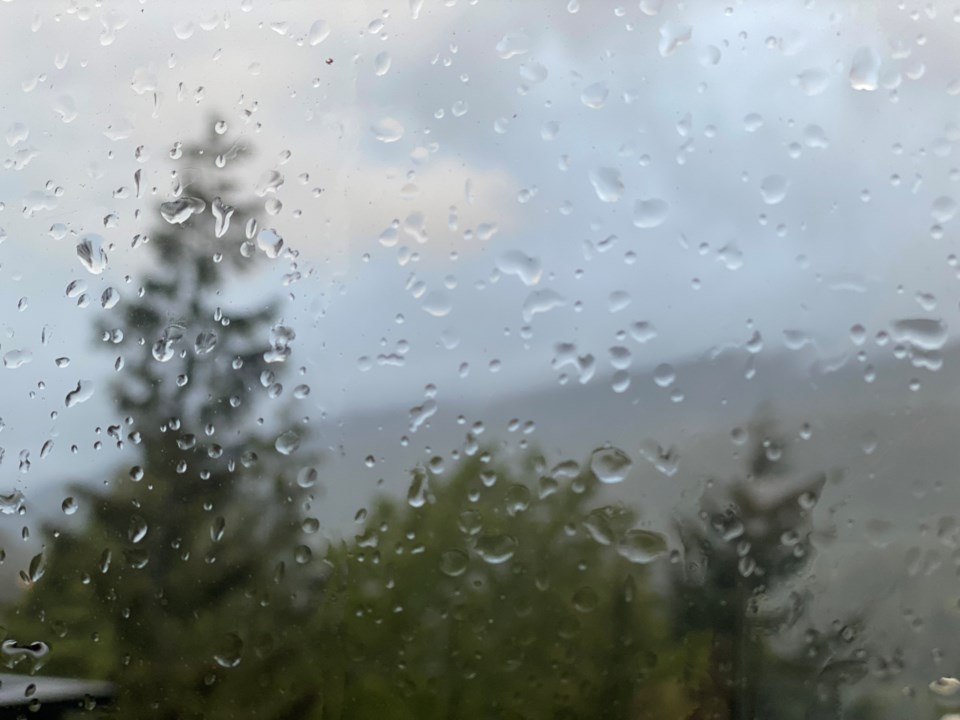A couple hours ago, a friend texted about some work-related thing. He padded his message with a conversational expression that should, if you’ve lived here long enough, be familiar to Whistlerites: “How about this rain?”
How about it, indeed.
For a spring season that started with the worrying warmth and dryness we’ve sadly come to expect, things sure shifted in a hurry. Only that morning I’d dropped my car at the mechanic in Function to have my tires changed over (thankfully the new summer rubber is anti-hydroplaning); as I walked the 4.5 kilometres home to Creekside in a deluge that easily found its way through the remaining molecules of Gore-Tex in my now-mouldering raincoat, I thought about the mess rain was making of my life. Not that anyone gives a rat’s ass, but I can’t carry out my annual spraying of burdock with death-dealing vinegar while it’s raining. Like my raincoat, the dog cannot dry off between outings and is now sporting sloth-like algae in its fur. And all the plants I fastidiously raised from seeds in April, hoping to transfer to my garden by now, aren’t going anywhere with nighttime lows bottoming out between +1 and -1; since they’ve now been re-potted twice each, my living room floor looks like a greenhouse complete with grow lights hanging from the window blinds. As of the time of writing (3 p.m.) the Government of Canada’s weather website shows the coldest reporting station in the province to be our own Callaghan Valley, at 6.3 C (the warmest was Ashcroft at a steamy 21.2 C).
In hindsight, April and May were pretty good months, weather-wise, certainly for spring skiing—much of which I did in conditions far better than what the past week has seen. And now, every time I look at the weather app on my phone the 10-day outlook has deteriorated. Worse, the high-tech meteorological magic we all rely on seems only to be messing with weather forecasters: yesterday, when I arose at 6 a.m., it showed a 15-per-cent chance of rain at around 10 a.m., then cloudy for the rest of the day; this seemed propitious for my multifarious plans. By 10:30 a.m. the forecast showed a chance of rain all day—a chance that turned out to be about 150 per cent and shut down pretty much everything I expected to do.
This is infuriating.
This is also perfectly normal.
People like to call out October and November, but when I think about it, for the quarter-century I’ve lived in Whistler, May and June have been by far the most miserable months: the hardest to predict and the ones that bring the nastiest surprises of cold or prodigious amounts of unforecast rain (I mean, June-uary is a thing—even if it tends to be instantly erased from memory by the first sunny, 20 C day). I’m the only one who thinks this, but I’ll be the first to admit my sense is partly tied to an expectation to get up-and-down spring weather over with and get on with summer; this notion has been exacerbated by summers over the past five years that literally started in April and erased knowledge of the compelling reason for unsettled weather: it’s spring. It’s transition time. Everything is turning over. Air masses are colliding. The sun is waxing. Ocean temperatures are shifting. Jet streams are moving. And 2023’s El Niño event, one of the strongest on record, with a litany of record-smashing land and ocean temperatures around the globe, is dissipating into meteorological bits and pieces, opening the door to its sister event, La Niña.
El Niño winters are generally warmer throughout B.C. and the Yukon, with less snowfall in southern B.C. La Niña winters show the opposite in southern B.C.—cooler conditions and greater-than-normal snowfall. Climate is naturally variable, so individual El Niño or La Niña episodes may not conform to generalized findings. In fact, an Environment Canada study found the most extreme winters (i.e., warmest and wettest) didn’t necessarily correlate with either. So it’s messy.
In a December 2023 release, University of Ottawa associate professor Hossein Bonakdari noted: “The warming of the Pacific Ocean’s surface waters has led to changes in global weather patterns, including increased rainfall in South America, droughts in Southeast Asia, and warmer temperatures in North America.”
While Bonakdari wouldn’t be shocked to see what happened across the globe since, he also explained that despite La Niña typically ushering in cooler and wetter conditions, the rise in global temperature could contribute to more unpredictable weather patterns in coastal B.C., which feels the primary effects of El Niño in Canada.
The main thing he and other forecasters point out is that a weakening El Niño no longer means relief from the heat. And that is squarely on human-driven climate change. Back in the day, as warmer-than-average ocean temps in the equatorial Pacific shifted to the more neutral levels of La Niña, we might have seen a cooler summer, but now, according to the U.S. National Oceanic and Atmospheric Administration (NOAA)’s Climate Prediction Center, climate change is keeping temperatures on a firm upward trend, as shown in current outlooks for North America.
Though I’m the last to cheer on climate change, at this point bring it on. I need to get these plants out of the living room and dry off my dog—and raincoat.
Leslie Anthony is a Whistler-based author, editor, biologist and bon vivant who has never met a mountain he didn’t like.




